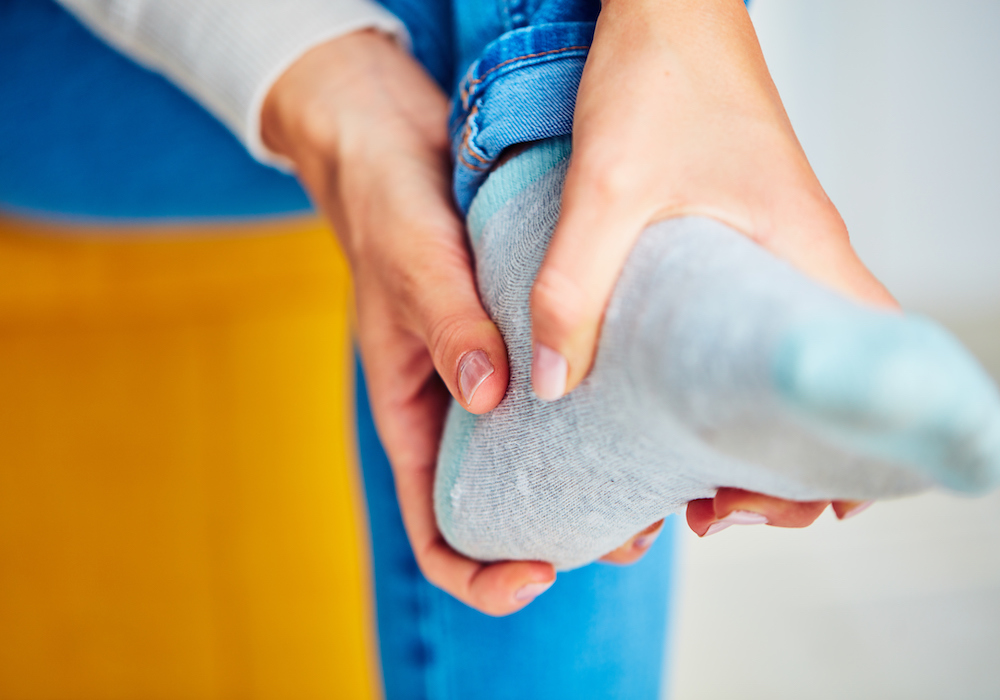THIS POST IS PART OF THE ULTIMATE GUIDE TO FOOT AND ANKLE INJURIES
The arch in your foot is important to help support your weight. If your arches become flat, you may have adult acquired flatfoot and you may need non-operative treatment to reduce your foot pain and regain your arch.
Anatomy:
On the inside of your ankle, there is a tendon called the posterior tibial tendon. This tendon causes your foot to bend inward and supports your arch. If you have adult acquired flatfoot dysfunction, it is usually because you have irritated and stretched out the tendon. This can turn into tendonitis, causing the posterior tibial tendon to stop doing its job and causing your foot to flatten.
It is important for your arches to be sturdy and flexible so they can support your weight on a variety of surfaces.
What causes flat feet in adults?
There are several causes for adult flatfoot, but most often flat feet is caused by posterior tibial tendon dysfunction, which is when the posterior tendon that supports your arch becomes stretched out, irritated and worn down. This is caused usually in athletes, patients with rheumatoid arthritis and individuals who are overweight.
Adult flatfoot is different than flatfoot found in some children. Many children have a condition called flexible flatfoot, which is when a child has an arch when they are sitting down or standing on their toes, but it disappears when they stand normally. Children usually grow out of this as their feet continue to develop.
Other causes of adult flatfoot include:
- Injury to the ligaments in the foot
- Arthritis in the foot and ankle joints
- Charcot foot

What are the symptoms of posterior tibial tendon dysfunction?
Depending on how severe your condition is and what it was caused by, adult flatfoot may not cause symptoms. The most common symptom is pain while walking or standing, usually radiating from the injured tendon or ligament in your foot.
If your adult flatfoot stems from posterior tibial tendon dysfunction, you may experience symptoms like:
- Pain along the back of the calf and inside of the ankle
- Swelling around the ankle
- Pain worsened by activity
- Balance difficulty
*If you are an adult with diabetes and believe you have adult acquired flatfoot dysfunction, consult a physician. Because of limited sensations in your feet, you may not feel the symptoms warning your body there is something wrong. If you notice swelling or a bump on the bottom of your foot, contact your physician for treatment options.
Can flat foot be corrected?
To determine whether you have adult acquired flatfoot dysfunction, your physician will ask you for a complete medical history, have you describe your symptoms and conduct a physical examination. An X-ray or MRI may be necessary to confirm the diagnosis and determine if there are other problems.
Adult flat foot can be corrected if you follow your physician’s recommendation for treatment after your diagnosis.
What is the best treatment for flat feet?
Treatment will range depending on what caused the injury and the severity of the adult acquired flatfoot dysfunction. The most common treatment is inserts for your shoes that support your arches, especially if your tendon is healing and cannot do its job correctly.
Other treatments include:
- Rest
- Bracing
- Walking boot for immobilization
- Over the counter pain medication
- Physical therapy exercises
If you follow your physician’s and physical therapist’s recommendations and treat your adult flatfoot, your tendon will likely heal without surgery, and your arch will return.
Schedule an appointment
Your well-being is important to us. Click the button below or call us to schedule an appointment with one of our orthopedic specialists. If your injury or condition is recent, you can walk right into one of our OrthoIndy Urgent Care locations for immediate care. For rehabilitation and physical therapy, no referral is needed to see one of our physical therapists.





